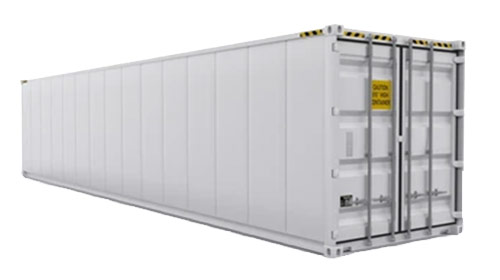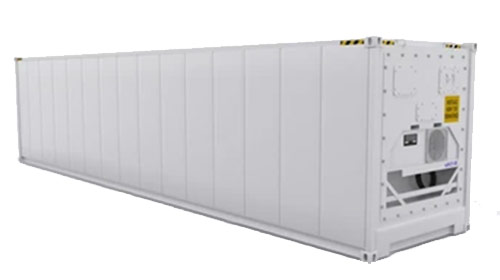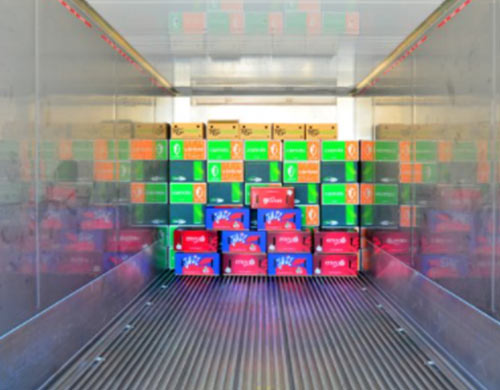Trade imbalances can cause equipment shortages in one region or country, and a surplus in another. For example, China is currently the largest net importer of reefer containers. This leaves many reefers stranded in China, having to return them back to the US empty, without being able to generate a profit. In order to work around this, shipping lines offer NOR services.
A Non-Operating Reefer (NOR) container is a refrigerated shipping container, with a disabled refrigeration unit. Instead of loading these reefers with temperature sensitive cargo, they are loaded with cargo that would typically be used for a general purpose container.
This helps shipping lines reposition reefer containers and lets shippers benefit from containers with discounted rates. From an ocean carrier’s point of view, all shipping containers are valuable assets that help to generate profit. Therefore, it’s always preferred to have the supply of reefer containers as balanced as possible.
How are Reefers Converted to Non-Operating Reefer Containers?
Once reefers arrive at the consignee’s premises, they are stripped off its temperature-sensitive cargo and returned to the carrier’s depot. Instead of having them idle in the container yard or having to send them back to the origin empty, shipping lines make them available as dry boxes, which allows them to reposition their reefers more efficiently.
Converting a reefer container into an NOR is extremely simple. The only thing that is required from shipping lines is to disable the genset of the container so that it doesn’t power the refrigeration unit.
It now becomes a Non-Operating Reefer container and also doesn’t have to be plugged into any sockets, practically operating as a general purpose container.
Non-Operating Reefer (NOR) Container Dimensions and Specifications
While NOR containers act as general purpose containers, there are several differences between the two with regards to dimensions and specifications.


| 20’ NOR Container | 20’ Dry Container | 40’ NOR Container | 40’ Dry Container | |
| Length (External) | 20’ (6,058 mm) | 20’ (6,058 mm) | 40’ (12,192 mm) | 40’ (12,192 mm) |
| Width (External) | 8’ (2,438 mm) | 8’ (2,438 mm) | 8’ (2,438 mm) | 8’ (2,438 mm) |
| Height (External) | 8’6”(2,591 mm) | 8’6” (2,591 mm) | 8’6” (2,896 mm) | 8’6” (2,896 mm) |
| Length (Internal) | 18’ (5,454 mm) | 19’4” (5,898 mm) | 38’ (11,588 mm) | 39’6” (12,032 mm) |
| Width (Internal) | 7’6” (2,294 mm) | 7’9” (2,352 mm) | 7’6” (2,280 mm) | 7’9” (2,352 mm) |
| Height (Internal) | 7’5” (2,273 mm) | 7’10” (2,393 mm) | 8’4” (2,537 mm) | 8’10” (2,698 mm) |
| Door Opening Height | 7’5” (2,264 mm) | 7’6” (2,280 mm) | 8’6” (2,569 mm) | 8’6” (2,585 mm) |
| Door Opening Width | 7’6” (2,290 mm) | 7’8” (2,340 mm) | 7’6” (2,290 mm) | 7’8” (2,340 mm) |
| Tare Weight | 6,482 lbs (2,940 kg) | 4,674 lbs (2,120 kg) | 10,362 lbs (4,700 kg) | 8,223 lbs (3,730 kg) |
| Max Payload | 60,715 lbs (27,540 kg) | 62,323 lbs (28,360 kg) | 66,800 lbs (30,300 kg) | 63,427 lbs (28,770 kg) |
| Max. Ocean Gross Weight | 67,197 lbs (30,480 kg) | 67,197 lbs (30,480 kg) | 77,162 lbs (30,300 kg) | 71,650 lbs (32,500 kg) |
| Cubic Capacity | 1,003 ft3 (28.4 m3) | 1,172 ft3 (33.2 m3) | 2,366 ft3 (35,000 kg) | 2,698 ft3 (76.4 m3) |
Here are the major differences between non-operating reefer containers and general purpose containers:
- Dimensions: While the external dimensions such as height, width and length are the same for both container types, NOR containers have smaller internal dimensions.
- Capacity: Due to the smaller internal dimensions, the internal capacity for NOR containers is less than dry containers. This is because NOR containers have a genset and a refrigeration unit (even though not used) and thicker insulated walls.
- Door Opening: NOR containers also have a smaller door opening in both width and height. This is also because of the thicker container walls.
When to Use Non-Operating Reefer (NOR) Containers?
Ocean carriers have full visibility on their reefer container inventory and are able to convert them into NOR containers at any given time, whenever they need to rebalance them.

Typically, if there is a reefer surplus the shipping line or freight forwarder may offer NOR containers instead of dry containers (general purpose containers) at a discounted rate. This ensures that their reefers are not subject to an empty repositioning trip and allows them to generate a profit.
For shippers, it means discounted rates for shipments using NOR containers, as opposed to standard containers. However, NOR containers may not be suitable for all types of shippers, as they can only transport certain types of cargo.
Therefore, it’s important to assess the suitability of NOR containers according to the cargo type, dimensions and specifications. Here is a list of goods that are suitable and not suitable for non-operating reefer containers:
Suitable NOR Cargo
- Electronic
- Apparel
- Fabrics
- Food Items
- Machine Parts
- Furniture
- Toys
- Beverages
- Footwear
- Books
- Accessories
- And Similar Items
Not Suitable NOR Cargo
- Dangerous Goods
- Rubber
- Chemicals
- Heavy Machinery
- Cement
- Batteries
- Metal
- Fertiliser
- Automobiles
- And Similar Items
What Are the Benefits of Non-Operating Reefer Containers?
There are three main benefits to using Non-Operating Reefer Containers compared to using general purpose containers. These benefits include cost saving opportunities to both shippers and ocean carriers, space prioritization and offsetting dry container shortages.
- Cost Savings – instead of the carrier opting for empty repositioning costs, they can make attractive offers for NORs to shippers with lower ocean freight rates.
- Space Prioritization – Since reefer containers can be in high demand in various ports of call, shipments loaded in NORs will typically be given space priority.
- Offsetting Equipment Shortage – Using NOR containers can offset equipment shortages of dry containers.
What Are the Limitations of Non-Operating Reefer Containers?
It’s important to know that NOR containers can also have several disadvantages or limitations. The main limitations are cargo suitability, decreased detention and demurrage free days and reduced shipment capacity.
- Selective Cargo: Not all types of goods can be loaded into NOR containers. The cargo has to be reefer-friendly and should ideally be evenly loaded throughout the container.
- Detention and Demurrage: NOR containers typically follow the detention and demurrage free days of reefers, which are typically less than dry containers.
- Reduce Capacity: Also important to note is that Non-Operating Reefer Containers have less capacity due to the refrigeration unit and thicker walls.
Things to Consider When Arranging a Non-Operating Reefer Container
When planning to use NOR containers in place of general purpose containers, there are a few things that should be considered. Firstly, it needs to be ensured that the ocean carrier has availability. It’s also important to compare the pricing of the Non-Operating Reefer Containers to the dry boxes.
There are of course other aspects that should be taken into account. Here are the most important ones:
- Cargo Weight. NOR containers have cargo weight limitations. This is because they have thinner flooring compared to the standard bamboo or wooden flooring in dry containers. The industry practice is to load at maximum 3,000/kg per running meter for NORs.
- Limited Lashing Points. Non-Operating Reefer Containers have limited lashing hooks compared to standard containers. Lashing hooks for NORs are located only at the bottom of the container.
- Internal Space: Space should be planned well ahead, with regards to total shipment weight and volume. This is because NORs offer slightly less capacity in comparison to general purpose containers.
With this in mind, all aspects should be considered before arranging a Non-Operating Reefer Container. If NORs are suitable and the limitations are acknowledged, they can save shippers a lot of money long-term.
What Carriers Offer Non-Operating Reefer Containers?
Almost all shipping lines who operate reefer containers also offer NOR services. This information is typically made available on the carrier’s website in their service brochure. Below is a list of the largest carriers offering NOR services, with a link for more information.
| Carrier | NOR Service |
| APL | Link |
| CMA | Link |
| COSCO | Link |
| DHL Global Forwarding | Link |
| DSV | Link |
| Evergreen | Link |
| Hapag-Lloyd | Link |
| Hamburg Sud | Link |
| Kuehne + Nagel | Link |
| Maersk | Link |
| MSC | Link |
| ONE | Link |
| OOCL | Link |
Case Study: Non-Operating Reefer Containers
Our scenario assumes the following market conditions: there is a reefer container surplus in a particular country, as they are a net importer of frozen food.
The shipping line lacks reefer containers in another country, as they are suffering from a reefer shortage. In order to offset this imbalance, the carrier offers selective shippers who are active in that particular trade lane, non-operating reefer containers at a discounted price with loading priority.
This enables the shipping line to reposition their reefers, while at the same time generating a profit, as the reefer containers don’t have to be transported back empty. The shipping lines adjust these discounted prices according to the supply and demand of reefer usage across their network for optimal repositioning.

Get Free Course Access
If you enjoyed the article, don’t miss out on our free supply chain courses that help you stay ahead in your industry.

Gerrit Poel
Co-Founder & Writer
at freightcourse
About the Author
Gerrit is a certified international supply chain management professional with 16 years of industry experience, having worked for one of the largest global freight forwarders.
As the co-founder of freightcourse, he’s committed to his passion for serving as a source of education and information on various supply chain topics.
Follow us